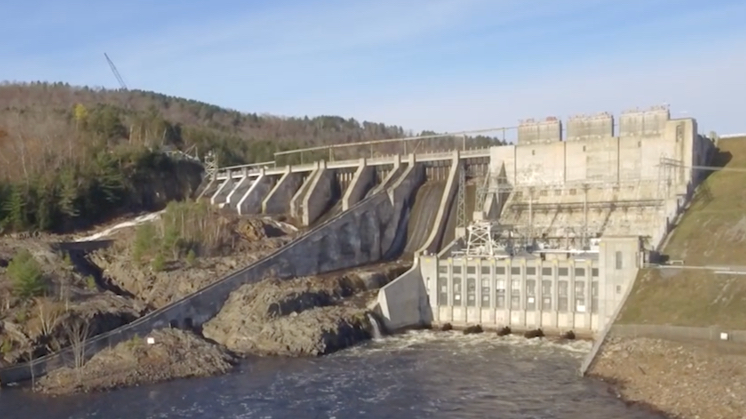
Even with the state legislature focused on lowering electric rates in Connecticut, the state and region may wind up with higher rates anyway due to tariffs on Canadian power recently announced by President Donald Trump.
Late Saturday, Trump announced 10% tariffs on Canadian energy and electricity sent to the U.S., along with 25% tariffs on other Canadian goods. That means any Canadian-sourced energy that goes into the New England power grid will have a 10% tax on it.
“There’s no question in my mind that our wholesale prices in New England will go up with these tariffs, assuming [the tariffs are] actually implemented and continued and kept on for a while. It’ll have to be passed on to customers at some point,” said Ken Gillingham, an environmental economist at Yale who specializes in energy and climate change.
That could cause the state and region’s historically high electricity costs to increase.
“Unfortunately that’s how things are looking,” Gillingham said.
In Connecticut, the utilities — Eversource and Avangrid — would not receive money from the tariffs. The cost of the actual power that people and businesses use is known as a pass-through. It appears on an electric bill, but that money just passes through to the company that generated the power.
Power from Canada is usually hydropower, though it can be other types, including solar and wind. It appears in grid operator ISO-New England’s data as imports, which in 2024 accounted for 9% of the power used on the grid. Imports include power directly from Canada as well as power from New York. But the New York power may also be sourced from Canada and routed through New York.
Imports are used most heavily in winter, when power sourced from natural gas is often diverted for heating. Just this Sunday, when temperatures dipped in the region and again today, imports accounted for more than 25% of power on the grid for a large part of the day. They were second only to natural gas-fueled power.
A statement posted by the ISO said it was reviewing the Trump administration’s announcement on tariffs on energy imports from Canada as well as assessing any potential restrictions on energy taken by Canadian officials in response to the tariffs.
Canadian Prime Minister Justin Trudeau announced a large number of retaliatory tariffs on American imports. They did not include energy products.
“We are seeking guidance from the administration on what, if any, role ISO New England will be required to have in implementing these tariffs,” the ISO said in its statement. “We cannot speculate on what, if any, impact these actions will have on wholesale electricity prices or the level of imports into the region.”
Gillingham reminds that the tariffs will infuse the whole of the New England economy as the cost of goods and services are adjusted to account for their rising power costs. Canada also sends natural gas and oil to the U.S. Those will also face 10% tariffs.
“It’s going in the wrong direction, but it’s not a very significant change,” said Sen. Ryan Fazio, R-Greenwich, the ranking member on the Energy and Technology Committee. “I do think the 25% tariffs across the economy are going to be more problematic than the 10% energy tariff.”
Fazio has been pushing for ways to lower energy costs in Connecticut. “I don’t know that it obviously changes much that we will do,” he said of the energy tariff.
“If I were a betting man, there’s nothing to believe that anything’s going down in the near term,” said Rep. Jonathan Steinberg, D-Westport, of the impact of tariffs on the state’s energy prices. Steinberg, who is co-chair of the Energy and Technology Committee, said affordability will likely continue to dominate the conversation about energy in the state. “The bottom line is, how could this be good for Connecticut? It isn’t.”
The tariffs come just as the region is completing a major transmission project called New England Clean Energy Connect that would bring 1,200 megawatts of hydropower from Quebec to the region. It has faced years of delays, and just a week ago Massachusetts finalized its payments as a result of the higher construction costs from those delays. The project is owned by Avangrid. It’s expected to be operational in 2026, but it’s unclear what the tariffs could mean for ratepayers once the system is operational.
“We estimate that electricity costs in New England alone will go up by as much as $200 million a year,” Massachusetts Gov. Maura Healey said in a statement released after the tariff announcement. “We need a partner in the White House who will lower costs for families and businesses in Massachusetts, and all we’ve seen thus far from this new administration are actions that will do the exact opposite.”
Connecticut’s Department of Energy and Environmental Protection has not responded to questions about what the Canadian tariffs could mean.
It’s also unclear what the tariffs might mean for existing contracts for Canadian power elsewhere in the region — especially in Vermont, which purchases a great deal of power from Canada.
Canada has also been considering new hydropower and onshore wind projects that could benefit the New England grid by helping it meet both increasing power demand and the climate goals of the various states. The impacts of tariffs on them are also unknown.
But in the shorter term, Gillingham said there’s no doubt that the final prices on the spot market will be higher. “There’s no way around that,” he said. “That is as immutable as it gets. There’s nothing in economics that’s fully immutable. But this is a prediction that I will stand by.”
